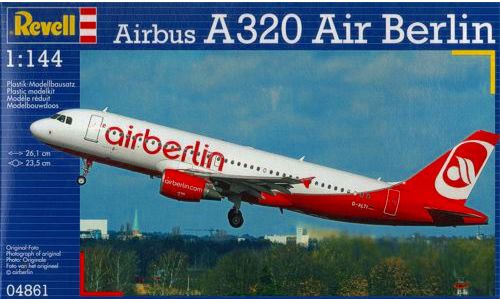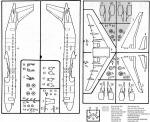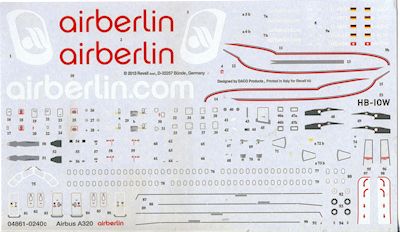
Revell 1/144 Airbus A.320
| KIT #: | 04861 |
| PRICE: | $20.99 |
| DECALS: | One livery, five serial options |
| REVIEWER: | Scott Van Aken |
| NOTES: |

| HISTORY |
The Airbus A320 family consists of short- to medium-range, narrow-body, commercial passenger jet airliners manufactured by Airbus. The family includes the A318, A319, A320 and A321, and the ACJ business jet. The A320s are also named A320ceo (current engine option) after the introduction of the A320neo. Final assembly of the family in Europe takes place in Toulouse, France, and Hamburg, Germany. Starting in 2009, a plant in Tianjin, China, has also been producing aircraft for Chinese airlines.[5] In April 2013, Airbus started construction of a new production facility for the A319, A320, and A321 variants in Mobile, Alabama. The aircraft family can accommodate up to 220 passengers and has a range of 3,100 to 12,000 km (1,700 to 6,500 nmi), depending on model.
The first member of the A320 family—the A320—was launched in March 1984, first flew on 22 February 1987, and was first delivered in 1988. The family was soon extended to include the A321 (first delivered 1994), the A319 (1996), and the A318 (2003). The A320 family pioneered the use of digital fly-by-wire flight control systems, as well as side-stick controls, in commercial aircraft. There has been a continuous improvement process since introduction.
In December 2010, Airbus officially launched the new generation of the A320 family with the A320neo "New Engine Option". The new generation offers a choice of the CFM International LEAP-X or Pratt & Whitney PW1000G, combined with airframe improvements and the addition of winglets, named Sharklets by Airbus. The aircraft will deliver fuel savings of up to 15%. Virgin America will be the launch customer for the aircraft in spring of 2016. As of December 2011, a total of 1,196 A320neo family aircraft have been ordered by 21 airlines making it the fastest ever selling commercial aircraft.
As of July 2013, a total of 5,677 Airbus A320 family aircraft have been delivered, of which 5,481 are in service. In addition, another 4,135 airliners are on firm order. It ranked as the world's fastest-selling jet airliner family according to records from 2005 to 2007, and as the best-selling single-generation aircraft programme. The A320 family has proved popular with airlines including low-cost carriers such as EasyJet who purchased A319s, and A320s, to replace its Boeing 737 fleet. The aircraft family competes directly with the Boeing 737, 717, 757 and the McDonnell Douglas MD-80.
| THE KIT |
 This
is not the first kit of the A320 family that Revell has kitted as they have done
at least the A.321 in the past. With that in mind, modelers of this aircraft
will not be surprised to find that many of the sprues and parts are the same
between the two planes. This one basically differs in the fuselage for the
shorter A.320. As a result, I was not surprised to find more flash than one
would expect on a modern kit.
This
is not the first kit of the A320 family that Revell has kitted as they have done
at least the A.321 in the past. With that in mind, modelers of this aircraft
will not be surprised to find that many of the sprues and parts are the same
between the two planes. This one basically differs in the fuselage for the
shorter A.320. As a result, I was not surprised to find more flash than one
would expect on a modern kit.
In line with most airliners, there is no cockpit or cabin detail. There are two ways to mold fuselages. One is with the myriad of cabin windows and the other is with a smooth fuselage. Revell seems to be in the initial camp, though unlike some companies, it does not include cabin windows, which would be a real chore to mask. Though there is no cockpit, there is a nose gear well that needs to be installed along with a whopping 20 grams of weight if doing the kit on the ground. An in-flight option is provided though you will have to come up with your own stand.
Since this uses the wing of the A.321, you have to remove a lot of small fairings from the underside of the wing. This aircraft uses the CFM 56 turbofans so be sure to pick the proper engine nacelles as two sets are offered. Landing gear appear to be quite sturdy for those of you doing your plane on the deck. A number of antennas are also part and parcel of airliners and this one is no exception. Clear bits are pretty well limited to the cockpit glass and wing tip lights.
 Instructions
are typical Revell, providing only Revell paint references, requiring some of
the colors to be mixed. The markings are for any one of five registration
numbers; four of them German and one Swiss. The color scheme is basically red
and white with all the red bits needing to be painted. Wings and stabs are in
greys with metal leading edges, as are the leading edges of the fin and engine
intakes. The red and silver cheat lines are part of the decals and making a scan
of them to provide a mask will help in getting all the red bits in the right
place on the fuselage. Decals are very nicely done and based on my experience
with new Revell AG decals, will work without any issues.
Instructions
are typical Revell, providing only Revell paint references, requiring some of
the colors to be mixed. The markings are for any one of five registration
numbers; four of them German and one Swiss. The color scheme is basically red
and white with all the red bits needing to be painted. Wings and stabs are in
greys with metal leading edges, as are the leading edges of the fin and engine
intakes. The red and silver cheat lines are part of the decals and making a scan
of them to provide a mask will help in getting all the red bits in the right
place on the fuselage. Decals are very nicely done and based on my experience
with new Revell AG decals, will work without any issues.
| CONCLUSIONS |
Airliner fans should be quite pleased with this one, despite the flash on the parts. It should be a fairly straight-forward build and give the modeler another nice scheme for the shelves.
| REFERENCES |
http://en.wikipedia.org/wiki/Airbus_A320
2014
Thanks to me for picking this one up.
If you would like your product reviewed fairly and fairly quickly, please contact the editor or see other details in the Note to Contributors.